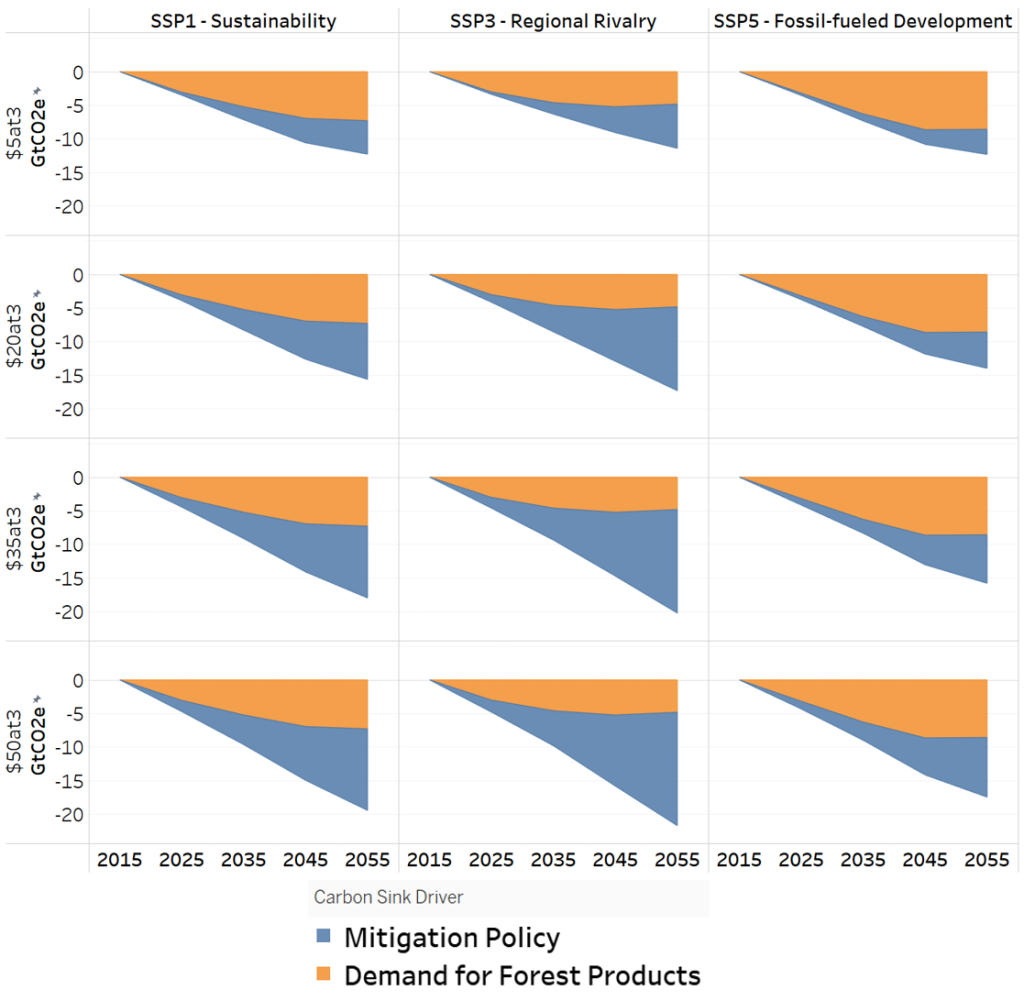Forest product demand growth can complement climate policy
In a recent publication, we quantified greenhouse gas (GHG) mitigation potential from U.S. forestry and agriculture under different socioeconomic scenarios. We used a detailed model of the U.S. land use sectors that was recently updated to illustrate how different socioeconomic development assumptions can affect mitigation costs and abatement portfolios. We find that mitigation potential from the U.S. land use sectors could be substantial — ranging 200-440 MtCO2 with a modest mitigation price of $20/tCO2 rising at 3% per year, with forest management playing a key role in projected mitigation portfolios. This analysis offers insight into how working forest and agricultural lands can support comprehensive climate action strategies in the U.S.
One of the more important findings is that higher forest product demand growth can complement climate policy goals by incentivizing investments in the forest resource base. These investments (e.g., planting, thinning, harvest pattern adjustments) can boost forest productivity and increase carbon sequestration rates. The concept that forest product demand growth can improve carbon outcomes is certainly not new, and has been supported by recent white papers, U.S. forest sector projections, and global assessment of wood-based bioenergy expansion. Other work suggests that policies that stimulate the demand for wood can complement direct payments for carbon sequestration.
However, this is the first attempt that we know of to disentangle carbon sequestration outcomes driven by forest product demand growth from policy-driven sequestration changes. We exploit different demand growth assumptions for forest products under our socioeconomic scenarios to quantify carbon stock changes over time. Thus, we can distinguish between projected sequestration changes driven by socioeconomic developments (baseline change) and then compare this to mitigation supported by direct price incentives that compensate foresters for additional sequestration above and beyond the baseline.
Using this approach we can visualize the difference in market- and policy-driven changes in forest carbon sequestration over time. The following figure builds on results in Wade et al. (2022). Here, we can see cumulative forest carbon sequestration changes over time across three different socioeconomic scenarios (SSPs) and carbon price scenarios (ranging $5-$50/tCO2 rising at 3% annually). Scenarios with high relative forest product demand growth (SSP5 and SSP1) see high levels of demand-driven changes in forest carbon sequestration (orange shaded area). Here, the forest sector anticipates future product demand growth and invests in new forests or shifts to more intensively managed forests with higher productivity (e.g., new plantations). This results in market-driven changes in sequestration, especially in the near term. In these high demand scenarios, it takes multiple decades and higher mitigation price incentives for policy to meaningfully influence carbon sequestration changes. Conversely, low demand scenarios (SSP3) show a higher proportion of policy-induced carbon sequestration change (blue shaded area). The opportunity costs of mitigation investments are lower under a low demand growth future, and less investment in carbon beneficial practices in the baseline offers more opportunities for the system to respond to a carbon price incentive.
Over the long-term, however, demand-driven changes sequestration begins to taper, and mitigation payments are needed to continue enhancing carbon sequestration. Hence, while demand stimulation may incentivize management changes that boost forest carbon, mitigation payments may be needed longer-term to continue increasing sequestration rates. Maximizing carbon sequestration in U.S. forestry may require a portfolio of policies that both compensate foresters directly for increased sequestration and indirectly incentivize investments in the resource base through market demand growth.

Figure adapted from Wade et al. (2022). Orange shaded area represents demand-driven changes in cumulative forest C sequestration relative to the base period. Blue areas represent policy-driven changes in cumulative forest C sequestration relative to each SSP baseline.
Reference:
Wade, C. M., Baker, J. S., Jones, J., Austin, K., Cai, Y., Bean, A., Latta, G., Ohrel, S., Ragnauth, S., Creason, J., McCarl, B. (2022). Projecting the impact of socioeconomic and policy factors on greenhouse gas emissions and carbon sequestration potential in U.S. forestry and agriculture. In press. Journal of Forest Economics.
- Categories: